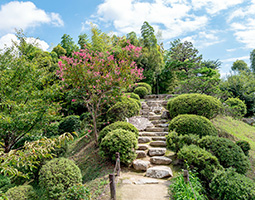April 2023
- English
- 日本語
Shukkeien, a Feudal Lord’s Garden in the City

View over Takuei-chi Pond and the Koko-kyo Bridge toward Seifukan, a tea house 
Takuei-chi Pond

Yuyu-tei, a pavilion overlooking Takuei-chi Pond 
Geiki-ho Peak, an artificial hill constructed to resemble Mt. Fuji and from which to view the garden

Shukkeien in Hiroshima City, Hiroshima Prefecture is a Japanese garden that has survived for 400 years despite damage from fires and the atomic bomb.

Shukkeien is a Japanese-style garden of about 47,000 square meters, located beside the Kyobashi River about 600 meters to the east of Hiroshima Castle (see here). It was built in 1620 as part of a villa for Asano Nagaakira (1586–1632)*, the daimyo (feudal lord) of the Hiroshima Domain, so the garden is more than 400 years old. Daimyo gardens were typically built within the grounds of castles so they were not exposed to attacks from enemies, and Shukkeien is said to have been the first such Daimyo Garden built outside castle grounds. The gardens were designed by Ueda Soko (see here), a man who served the Asano family as a chief retainer and who was known as a tea master and garden designer. Unlike the present garden, when Shukkeien was first built there were few trees, grass was planted on the tsukiyama artificial hills, and gravel was scattered around the tea house. It is thought that the purpose of these design choices was to allow for the immediate discovery of intruders.
However, in 1758, Shukkeien and a wide area of the Hiroshima Castle town were burned down in a major fire. To rebuild the garden, a gardener from Kyoto was invited and large-scale renovations took place between 1783 and 1788, creating the garden much as it appears today. The garden suffered catastrophic damage again due to the atomic bomb dropped on August 6, 1945, but work was done to restore the garden over the course of about 30 years starting in 1949, and the garden regained its original beauty.
“Shukkeien is not big compared to other daimyo gardens that remain today, such as Korakuen** in Okayama Prefecture and Kenrokuen*** in Ishikawa Prefecture,” says Kobessho Tomoaki, who works at Shukkeien. “However, as the garden is a kaiyu-style garden (a garden with circulating paths) with islands in the middle of the central pond, bridges here and there, man-made hills, bamboo groves, and a tea house, all perfectly arranged around the undulating grounds, the garden doesn’t feel small.”

Located in the center of the garden is the roughly 8,000 square meter Takuei-chi Pond, with three Crane Islands and eleven Turtle Islands****, since cranes and turtles are thought to be auspicious. It is said that these islands represent the many islands in the Seto Inland Sea, which Hiroshima faces. Water drawn up from the Kyobashi River is used for the pond. Since the Kyobashi River here is close to the river mouth where it empties into Hiroshima Bay, its water is a mixture of freshwater and saltwater, allowing both freshwater fish like koi and saltwater fish like flathead grey mullet to swim together in the pond.
The Koko-kyo Bridge, a stone arch bridge, spans the center of the pond. The bridge remains in the same state as when it first spanned the pond some 240 years ago, having withstood the blast of the atomic bomb. There are also pavilions by the side of the pond, such as Yuyu-tei, where visitors can take a seat and relax as they enjoy viewing the garden.
Geiki-ho Peak is an approximately 10-meter-tall artificial hill by the pond said to resemble Mt. Fuji, and from the top, you can see the entire garden. Some time ago, before there were tall buildings around the garden, it was possible to see Hiroshima Castle, Hiroshima Bay, and even all the way to Miyajima (see here) from here.

There are around 5,600 trees planted within the garden. Among the varieties, pine trees are the most numerous, numbering around 370 trees. These evergreen pine trees are skillfully pruned by the gardeners. There are also around 110 cherry trees, with beautiful blossoms blooming in spring. In autumn, Japanese maple and other trees produce colorful autumn leaves. A large gingko tree in the garden that survived the atomic bomb stands 17 meters tall, has a trunk 4 meters wide, and is estimated to be more than 200 years old.
A variety of events are held in the garden throughout the year. For example, seasonal tea ceremonies are held at the Seifukan tea house. In the past, the feudal lord would pick tea and plant rice in the garden. Those activities have been recreated in the form of a Tea Harvesting Festival in late April and a Rice Planting Festival in mid-June each year.
“As there are a variety of flowers and events throughout the seasons to enjoy, many visitors come back to the Shukkeien repeatedly,” says Kobessho. “Despite being in the middle of the city, you can experience a quietness that feels like a different world. I want to convey the allure of the garden to people from Japan and abroad, while continuing the traditions that have been passed down for 400 years.”
* Asano Nagaakira was the first Asano family daimyo of Hiroshima. He governed the domain from 1619.
** See Highlighting Japan May 2021, “Okayama Korakuen: A Daimyo Garden Full of Charm” https://www.gov-online.go.jp/eng/publicity/book/hlj/html/202105/202105_04_en.html
*** See Highlighting Japan May 2021, Kenrokuen: The “Outstanding Garden” of the Kaga Domain https://www.gov-online.go.jp/eng/publicity/book/hlj/html/202105/202105_03_en.html
**** Each island resembles a crane or turtle.

